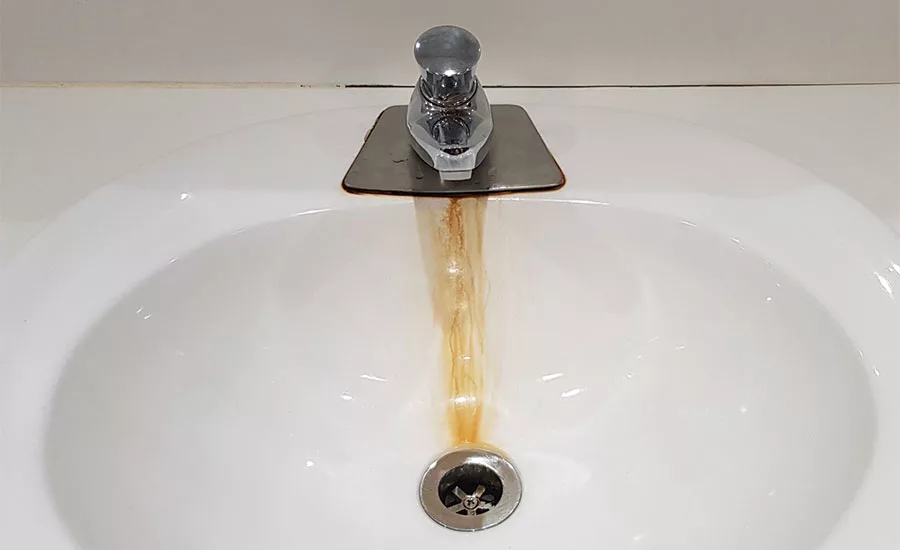Effective, Simple Method to Remove Iron from Groundwater

Over my last few columns, I have written about troubles with iron in well water. (It can, of course, occur in any kind of water, ground or surface.) Professionals have used many methods over the years to get this iron out of the water. I understand that anywhere from 0.25 ppm to 0.3 ppm iron content is enough to cause staining. I don’t have to overemphasize how unhappy consumers are with water that stains. Just about all the groundwater in Michigan has many times that stain level so, as I have written, high-iron water has been a real problem — at least until recently.
Manufacturers tried many ways to change clear-water iron to what, in effect, is rusty water iron. The rusty water can be filtered, and the iron in the water is history. Most of the methods used to change the chemistry of the water were a bit difficult and, sometimes, complicated. Finally somebody — and I don’t know if it was an academic, a manufacturer or an installer — figured out a relatively simple way to aerate the water and oxidize the iron. This oxidizing is done inside a tank. I understand that this is sometimes done in a single tank, but my experience is with two-tank units and I can assure you they work like a charm. I know this from personal experience and it works just great on my well water, which has nearly 3.0 ppm iron.
The unit that I speak about that is most effective has two tanks. One tank is filled with air and the other tank has a filter media, which can vary with the chemical makeup of the water but is usually just silica sand. Water from the source enters the air tank first, the iron is oxidized and then strained out in the mineral tank, and the iron-free water goes on to its final point of usage and, many times, through a water softener. This, readers, is simplicity in itself and really does work. Although I have never installed one, I understand there are single-tank versions of this that combine the air and media in one tank. These are often used where there are space limitations, and I am told that they are not as effective as two-tank models.
The backwash procedure on these two-tank systems is to reverse flow and run the backwash water to a drain, flushing out the trapped iron particles. In the next step, which is called slow rinse, new air is drawn into the air tank, which is generally the left-hand tank as installed. The last step of regeneration is rapid rinse, which removes the last of the trapped particles and compresses the air in the air tank to about 14 inches in height. The new air put into the air tank is drawn in with a venture, much like the venturi that “sucks” saltwater into a water softener. The air inlet is equipped with a strainer and a check valve, so no water is spilled onto the floor. Regeneration of these units is recommended every three days and I can understand that; we don’t want the filter bed to become too compacted. As I said before, these units really do work and I have never had a complaint about one — least of all from my wife.
I am adding some technical facts about these filters. There are three types of media available, depending of the chemical makeup of the water. The types needed depend on the pH of the water, whether it is more or less than 7.0, and if there is manganese present or not. If water is to be taken from the piping system ahead of this filter for a sillcock, heat pump or to feed another building, an in-line check valve must be installed just ahead of the inlet to the filter. A final note: The first gallons that come from this filter after regeneration may contain many bubbles of air, giving the water a milky look. These will “fizz” out in a few seconds and the water will be crystal clear.
This concludes what I think is the way to remove iron from water. I do note that the installation manual calls this system an iron reduction system not a removal system.
Over the many years I have written this column, I have kept it non-commercial. For this column, though, I want to thank Steve Hamilton of Sterling Water Treatment/First Sales in Churubusco, Indiana, for checking my technical facts. Next time, I have a short story about my old friend potassium permanganate and will write about some pipe lifters, as requested by a reader named Fred.
We have had a decent summer here in Michigan and all the pump men and drillers I know are very, very busy. The last few days have been quite hot for this region with temperatures in the mid-90s and high humidity. The alarmists on TV would have you believe that merely stepping outside is dangerous to one’s health. I don’t believe it. In my area, we have had little rain so while my lawn is somewhat green I have a huge crop of buckhorn, a nasty weed that looks a bit like a wheat stalk. I know, because I mowed them off yesterday. Until next time, keep cool while working and drink plenty of good iron-free water.
For more John Schmitt columns, visit www.thedriller.com/schmitt.
Looking for a reprint of this article?
From high-res PDFs to custom plaques, order your copy today!




